From Sweet to Heat: A Farmers Market Guide to Peppers
September 5, 2025
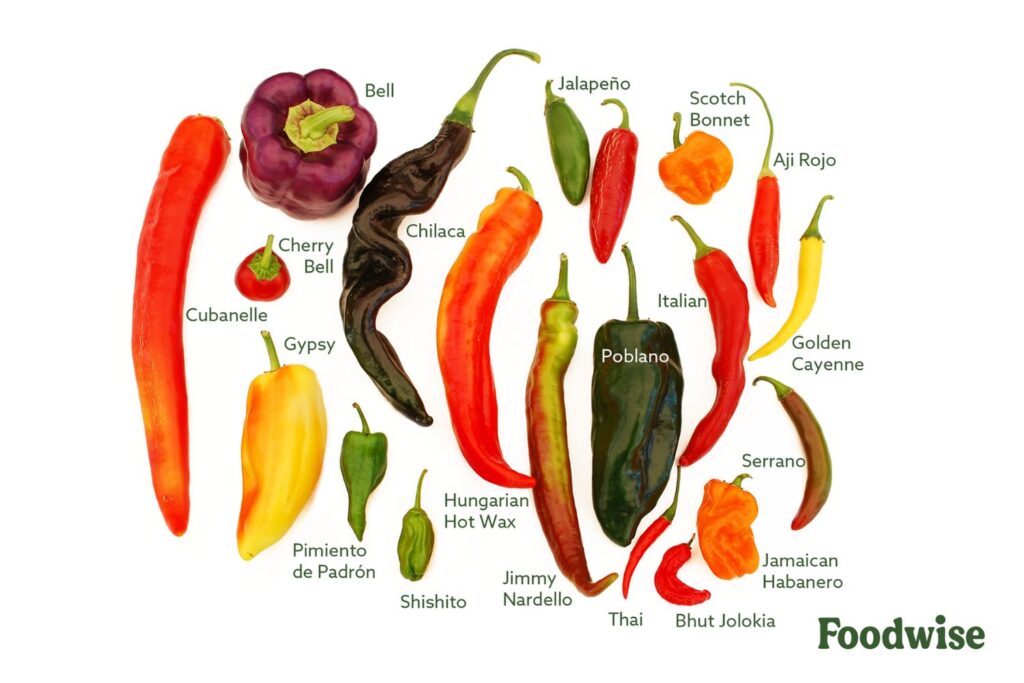
Pepper season is heating up! Native to the Americas, the fruits of Capsicum annuum are in full force at our farmers market from late summer into early fall, where you can find dozens of varieties in just about every color of the rainbow.
Low- to no-heat varieties like bells are generally called sweet peppers, while spicy varieties are commonly referred to as chiles. Pepper heat is based on the level of capsaicin, a chemical compound that creates a burning sensation on contact with mucous membranes, like the skin in our mouths. It is measured in Scoville heat units (SHU), a scale developed by pharmacist Wilbur Scoville in 1912.
For a bit of perspective, bell peppers are 0 SHU, Tabasco sauce is 2,500–5,000 SHU, pepper spray is upwards of 2,000,000 SHU, and pure capsaicin is 16,000,000 SHU. Capsaicin is usually concentrated in the seeds and ribs of the chile, so those can be removed to soften the kick.
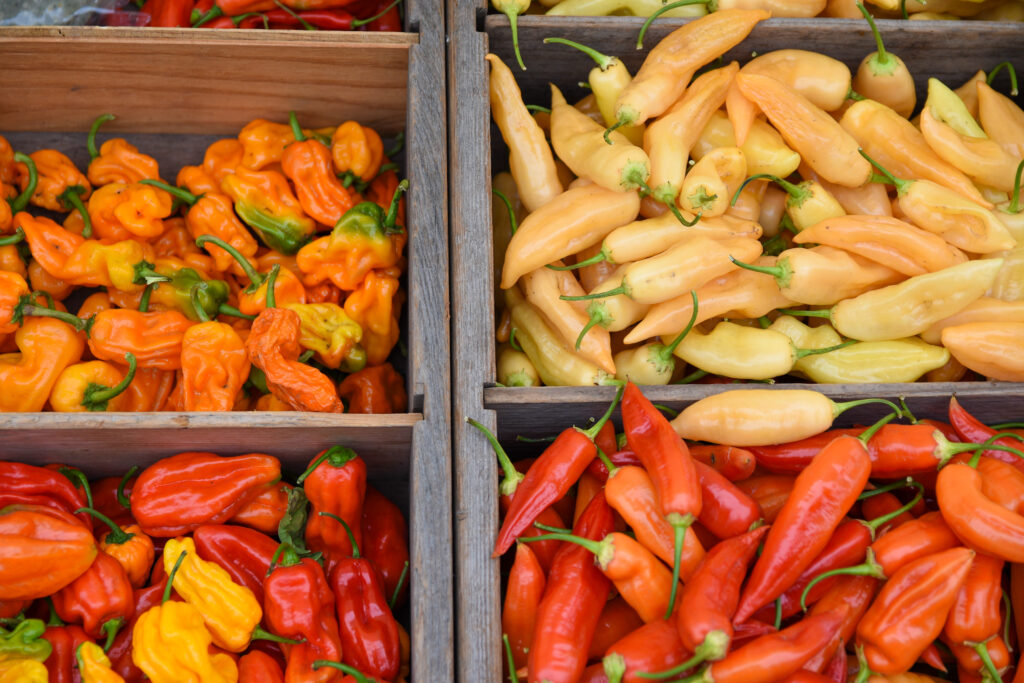
When picking fresh peppers, look for deep, rich colors and glossy skins, and avoid wrinkles and bruising. As they ripen, many peppers change color from green to other bright colors, and some get spicier. When working with hot chiles, avoid contact with your eyes and always wash your hands thoroughly with dish soap, or use gloves.
By no means a definitive list, here is a guide to some popular peppers at the farmers market, along with a few rarer ones. Peppers are ordered from mild to spicy, with Scoville heat units noted in parentheses. This September, stop by the orange Seasonal Spotlight tent at Foodwise farmers markets to try a wide variety of delicious, pepper-centric recipes, and be sure to join us at the Pepper Palooza on September 27.
Get Peppers at These Farms at Foodwise Farmers Markets
Allstar Organics | Eatwell Farm | Everything Under the Sun | Gavel’s Farm | GG Farm | Green Thumb Farms | Heirloom Gardens | Lonely Mountain Farm | Lucero Organic Farms | Oya Organics | RHJ Farms | The Peach Farm | Tierra Vegetables
Sweet or Mild Heat
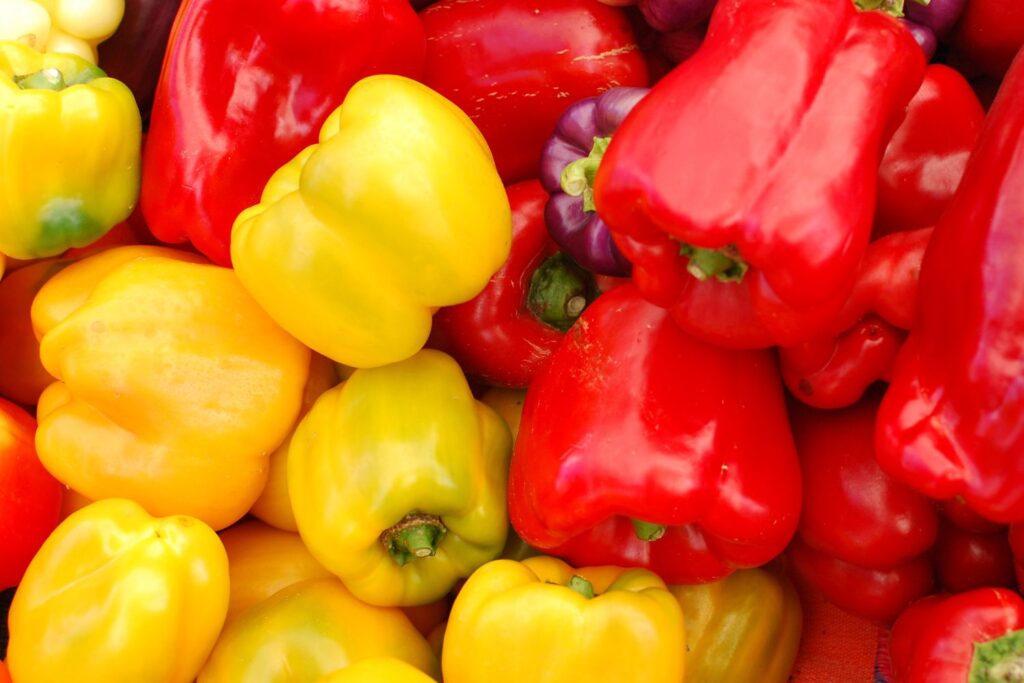
Bell peppers (0)
These sweet, mild peppers can be found in a variety of shapes, sizes, and colors, from the ubiquitous red, green, and gold to orange, purple, and even chocolate brown. Bell peppers contain a variety of vitamins and antioxidants, such as beta carotene. A single red bell pepper has three times more vitamin C than an orange! Bell peppers do not contain any capsaicin, making them a delicious addition to salads, stir-fries, and other dishes, either raw or cooked.
Recipe to try: Muhammara by Naomi Webb, Foodwise’s Culinary Program Manager
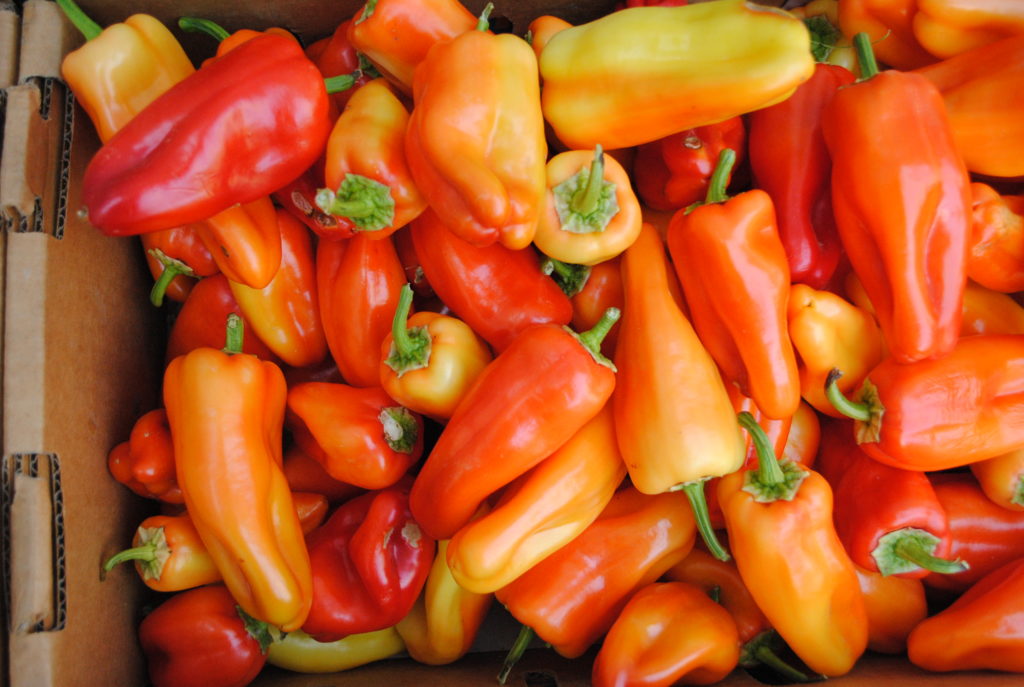
Fryer peppers (0–1,000)
Sweet frying peppers are a broad category that includes long, thin-fleshed varieties, such as Cubanelle, Italianelle, Gypsy, and Jimmy Nardello. Their mild flavor is enhanced when sautéed with a bit of oil. Pair them with aromatics such as ginger, garlic, and shallots.
Recipe to try: Little Gem Salad with Corn and Jimmy Nardello Peppers by Pam Mazzola, Prospect
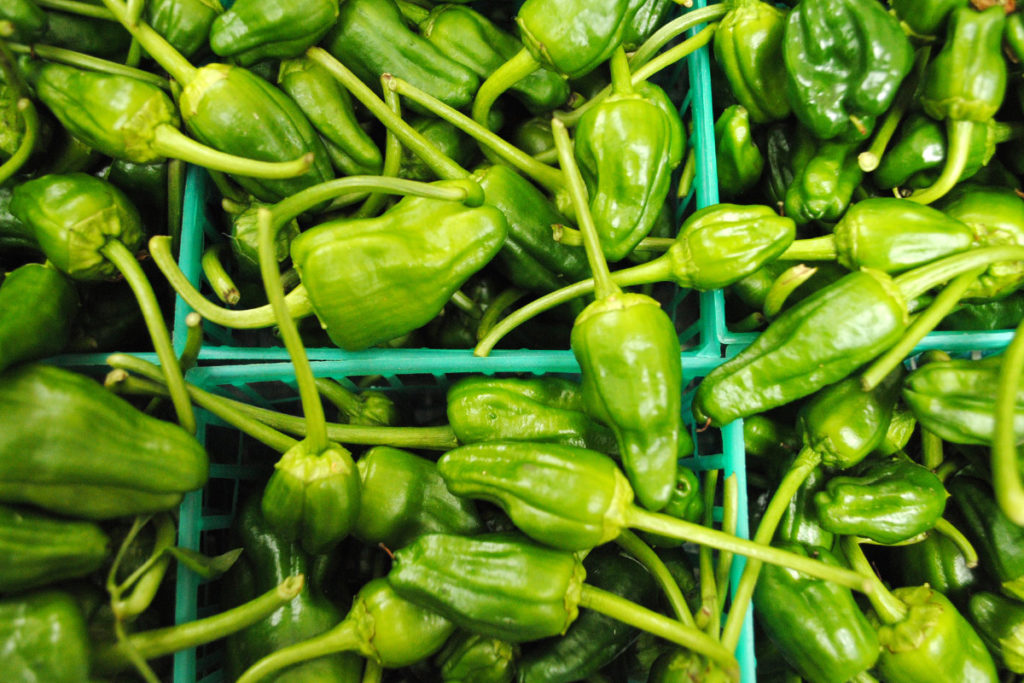
Pimiento de Padrón (0–3,000)
Generally harvested in their green, mild state, this small, flavorful fryer heats up with maturity. For a delicious appetizer that is popular in northern Spain, remove the stems, fry them in olive oil until they’re soft and the skins are slightly charred and blistered, then toss with sea salt and serve.
Recipe to try: Baked Feta and Peperonata by Katie Reicher, Greens Restaurant
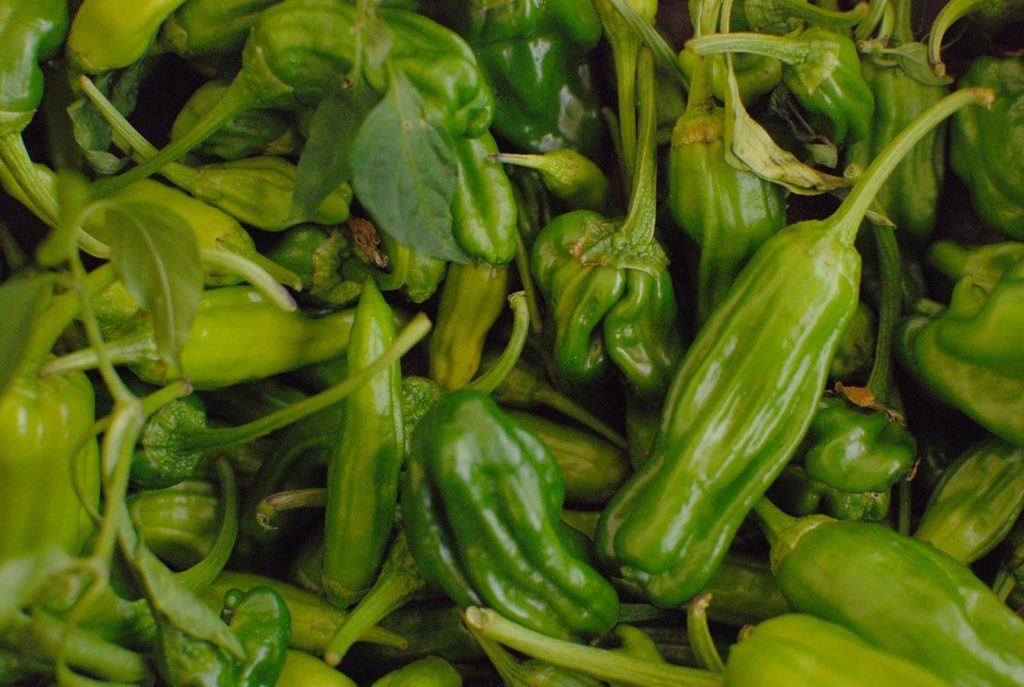
Shishito (50–1,000)
This small, green Japanese pepper is named for its tip’s resemblance to a lion’s face. Similar to Padrón peppers, shishitos are picked when immature and sweet, and about one out of 10 peppers is spicy, so be prepared. Blistered and salted shishito peppers are a popular appetizer, and they can also add a satisfying flavor to stir-fry dishes.
Recipe to try: Charred Shishito Peppers with Goat Cheese and Sage by John McReynolds, Stone Edge Farm Estate Vineyards and Winery
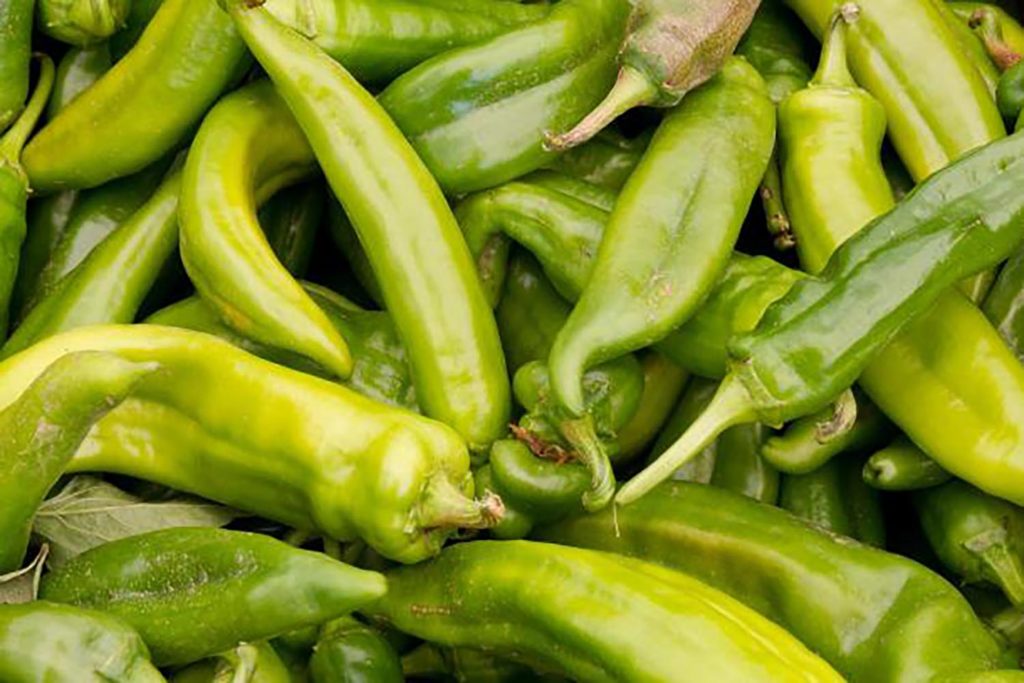
Anaheim (500–2,500)
Hailing from New Mexico, this large, long, light green pepper takes its name from the Southern California city where it was popularized. Younger green Anaheims will have a mild and peppery taste, while their more mature, red counterparts get sweeter with age. Sweet with a bit of spice, it is frequently used in salsas, stuffed, or dried into ristras for later use.
Recipe to try: Suki Bhaji Okra (North Indian Stir-Fry Okra) by Shanta Nimbark Sacharoff, Cooking Together
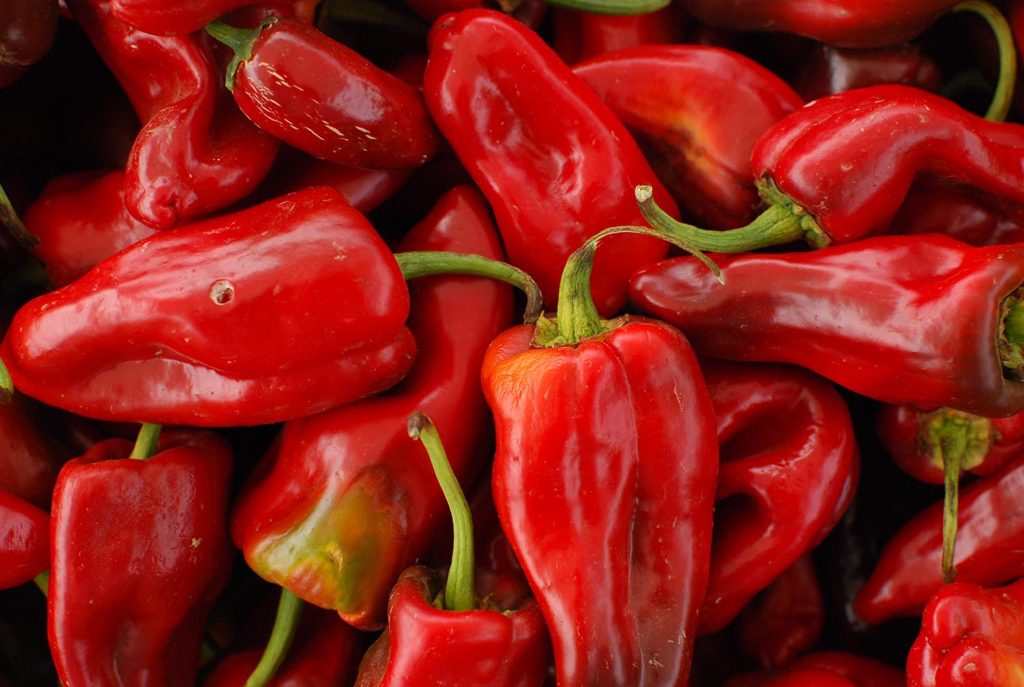
Poblano (500–2,500)
This mildly spicy dark green chile originating from Puebla, Mexico, is traditionally stuffed, breaded, and deep-fried for chile rellenos. When dried, it is known as an ancho, a common ingredient in the classic Oaxacan sauce mole poblano. When roasted, their waxy skin gives a paper-like texture that many find unpleasant. Be sure to gently scrape away the skin after roasting.
Recipe to try: Pasta with California Pepperonata by Sandy Sonnenfelt, Market Hall Foods
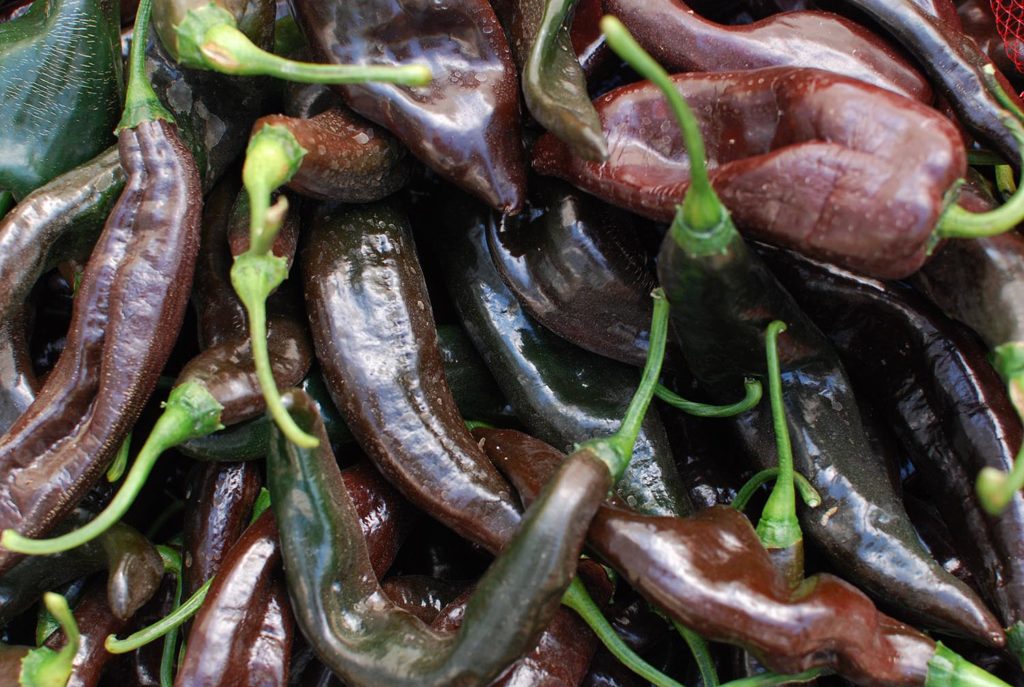
Chilaca (1,000–2,500)
Green-black with a long, twisted shape and a rich flavor, the Chilaca is widely known for its dried form, the pasilla, which is used in mole negro. Fresh chilacas are a rare find outside of farmers markets. The pepper is named for its wrinkled appearance, with the term “Chilaca” meaning “old” or “gray hair.”
Medium Heat

Jalapeño (2,500–8,000)
Native to Veracruz, Mexico, the jalapeño is perhaps the most popular hot chile in the world. It is generally green when harvested, but can also be found in a ripe, crimson red form, which is equally spicy. Thick-skinned and easily seeded, the jalapeño makes a perfect receptacle for cheese, fried, roasted, and even wrapped in bacon. When smoked and dried, it is called a chipotle.
Recipe to try: Huevos a la Mexicana y Hongos Con Queso by Guadalupe Moreno, Mi Morena
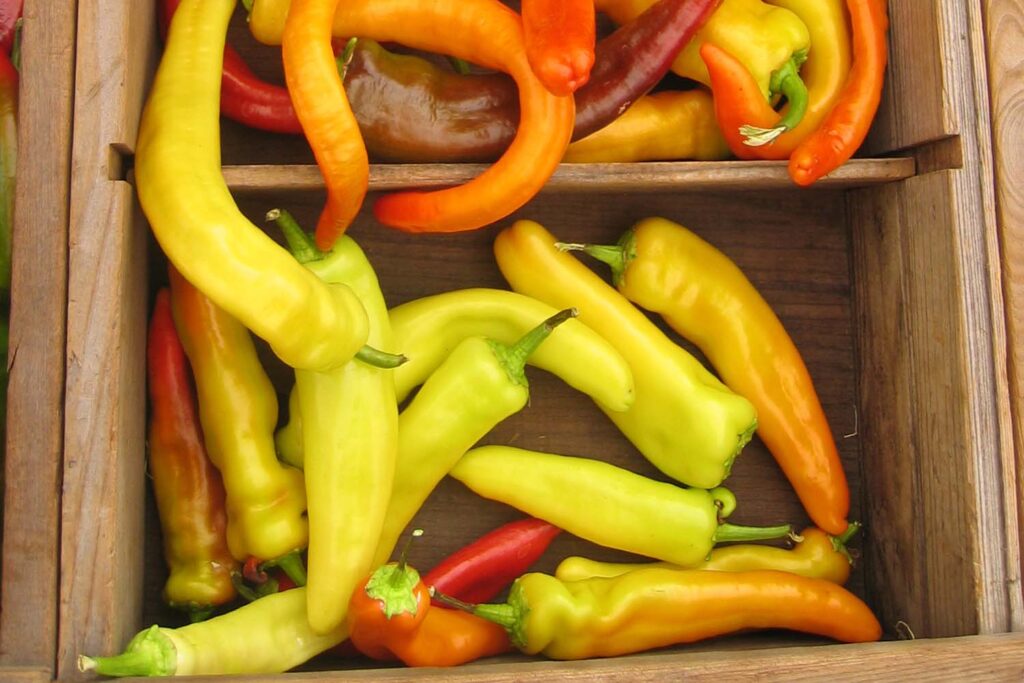
Hungarian wax (3,500–8,000)
Sometimes mistaken for the sweet and mild banana pepper, these long yellow to red peppers are considerably hotter than they look. These peppers are a staple in traditional Hungarian dishes such as goulash (a beef and vegetable stew) and can also be found in chiles, salads, sandwiches, and pizzas. Though these peppers are named for the waxy texture of their skin, the waxiness does not impact the chile’s flavor.
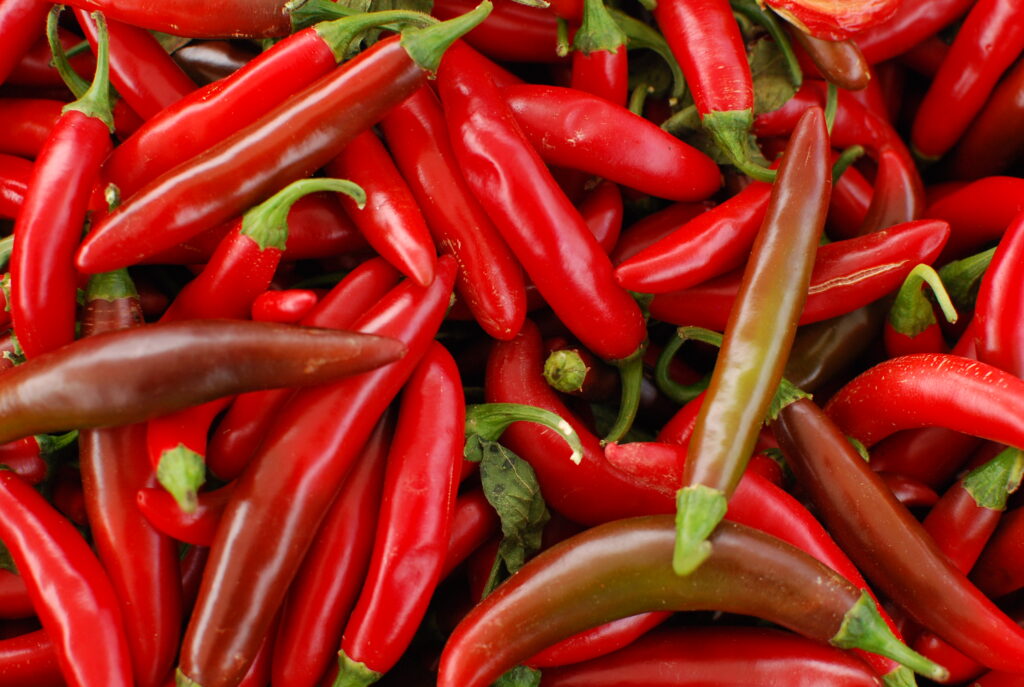
Serrano (10,000–23,000)
Found in green and red, the fleshy serrano turns up the heat a few notches. It is often used raw in spicy salsas and guacamoles. If you want to remove some heat before cooking, take out the white pith from the cavity of the pepper. This membrane holds a large portion of the pepper’s heat.
Recipe to try: Grilled Lamb Pinchos (Skewers) with Pickled Tomato, Summer Peppers, and Peaches by Mat Schuster, Canela
Extremely Hot

Cayenne (30,000–50,000)
Usually found dried and ground as a spice, this long pepper packs a punch. The ripe, fresh version can be found at farmers markets in hues of red to yellow. It is often found in Asian dishes and hot sauces. Try pairing your cayenne with honey, lemon, or cinnamon to create unique flavors in your favorite dishes.
Recipe to try: Gado Gado-Style Salad with Pan-Seared Tamarind Tempeh and Chili-Almond Sauce by Sascha Weiss, Project Juice
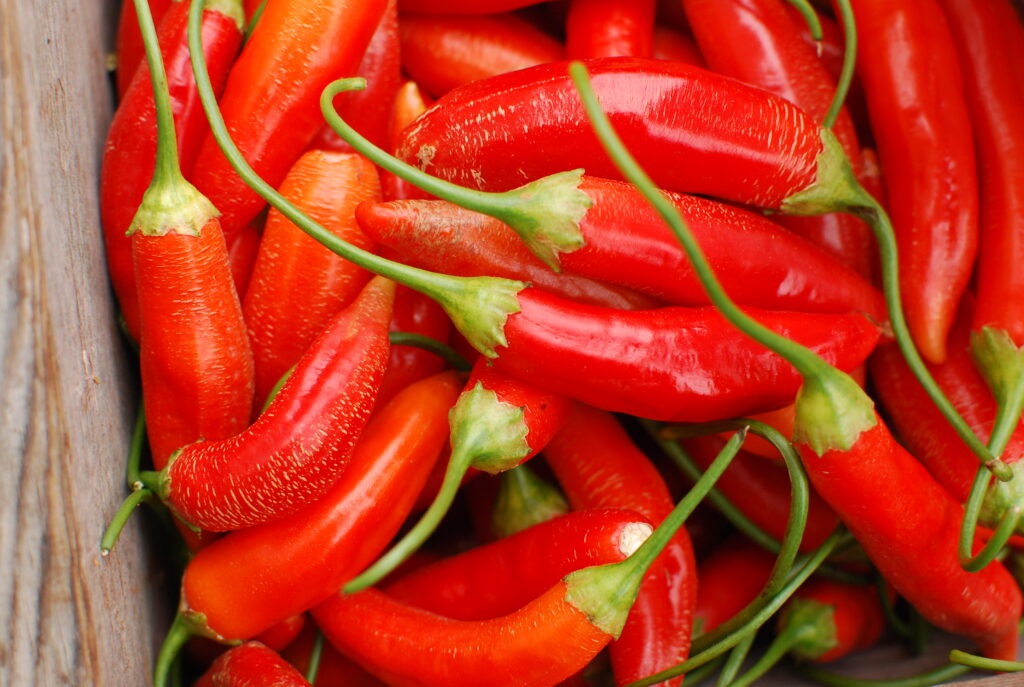
Aji rojo (30,000–50,000)
This bright orange-red Peruvian pepper packs a lot of power, making a sizzling addition to ceviche. Aji rojo peppers can also be chopped and added to soups, stews, hot sauces, and marinades for an added kick. If whole and unwashed, these peppers will keep for up to two weeks in the refrigerator.
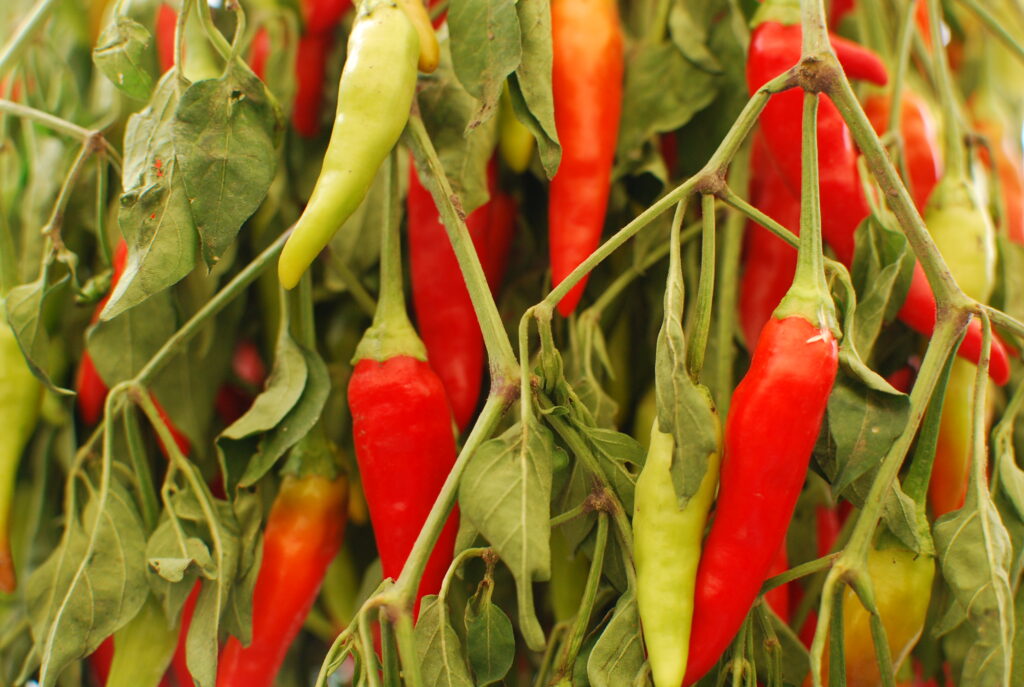
Thai chile (50,000–100,000)
The Thai chile (also known as a Bird’s Eye chile) is a tiny scorcher available in red, orange, and green varieties, all commonly used in Southeast Asian cuisine. Both the peppers and their leaves can lend an earthy flavor to stir-fries, as well as boiled and sauteed dishes .
Recipe to try: Thai Red Curry by Chef Thassanee Ruthaiwat
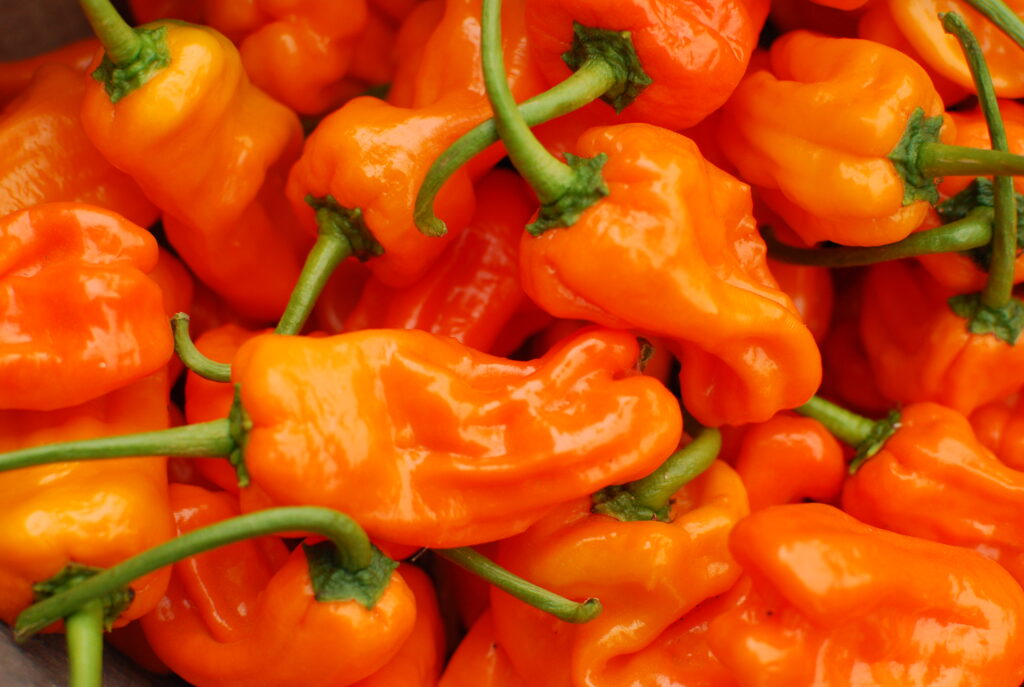
Habanero (100,000–350,000)
Native to South America but named after the city of Havana, the habanero is a fiery little lantern with fruity notes, making it a favorite ingredient in hot sauces. It is similar in shape and heat (but not to be confused with) the larger Scotch bonnet. These peppers can also be chopped into chutneys, salsas, and other toppings, where their tropical sweetness can be paired with other ingredients to create a balanced sweet and spicy flavor.
Recipe to try: Tender Pork Belly with Habanero Chili, Apricot Jam, and Parmesan Grits by Goran Basarov, Balboa Cafe

Bhut Jolokia (855,000–1,000,000)
Nicknamed the “ghost pepper” for its reputation to cause people to “give up the ghost,” this wrinkly, red, supernaturally hot hybrid cultivated in Northern India was once considered the hottest in the world (a title now held by Pepper X, with 1,400,000+ SHU, followed by the Carolina Reaper and Trinidad Moruga Scorpion). So, how hot is it? Well, it has 400 times as much capsaicin as a jalapeño. In short, proceed with extreme caution.
This article was updated from a previously published version.
Topics: Culinary, Farmers market, Produce guides, Vegetables
